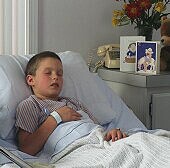
MONDAY, March 7 (HealthDay News) — Young adults who had cancer, diabetes or epilepsy as children are less likely to achieve the same level of education or employment as their healthy counterparts, researchers report.
Improved medical care over the past 40 years has meant more children who suffered from chronic illness are surviving into adulthood. However, they carry the burden of their illness with them years later, often struggling with physical and emotional problems as adults, the study authors explained.
“The majority are successful, but they are at a greater risk of being unemployed, not completing their education and receiving financial assistance,” said lead researcher Dr. Gary R. Maslow, from the University of North Carolina at Chapel Hill.
The reasons for these problems are varied and complex. More effort is needed to help these survivors cope with the problems they face as a result of having been so seriously ill, he said.
Problems, according to Maslow, include family stress and the toll fighting the disease has on school work and finding a job later.
Growing up with an illness can cause the family to be stressed, he said. “It’s a financial hardship for families and that may make it harder to provide their kids with certain opportunities that can be crucial in education and employment,” he noted.
“For people with chronic illness, there are a lot of challenges educationally that are related to missing school and the effect of taking medicine,” he said. Unlike the support available in public education for people with learning disabilities, those with chronic illness are not necessarily the ones people are concerned about educationally, he added.
Struggling in high school may lead to problems getting and holding onto a job, Maslow said.
The report is published in the March issue of the Archives of Pediatrics & Adolescent Medicine.
For the study, Maslow’s team collected data on 13,236 young adults who took part in the U.S. National Longitudinal Study of Adolescent Health. The researchers compared those with asthma or other chronic illness, such as cancer, diabetes and epilepsy, with people who did not have these conditions.
Among those included in their analysis, 16 percent suffered from asthma and 3 percent had cancer, diabetes or epilepsy.
The researchers found that 81 percent of those who had a chronic condition graduated from high school and 60 percent had jobs.
Yet, those with chronic conditions other than asthma were less likely to graduate high school or ever have a job. They were more likely to receive public assistance, such as the Supplemental Nutrition Assistance Program and SSI/disability insurance, and were also more likely to live at home, Maslow’s group found.
“We need to focus on supporting the educational and vocational outcomes of these patients,” Maslow said. “With so many more of these patients surviving, we need to promote their overall well-being and help them to thrive as adults,” he added.
“We know from day-to-day practice that these kids miss more school, have more difficulty in school and have more difficulty graduating,” said Dr. Judith Schaechter, an associate professor of pediatrics and adolescent medicine at the University of Miami Miller School of Medicine.
“We know that is related to their chronic illness, because they are absent for hospitalization, doctors’ visits or the illness itself,” she noted.
In addition, medications can interfere with concentration and make it hard to get work done, added Schaechter, who was not involved with the study.
These children need extra support at home and at school, Schaechter pointed out.
“The message I want to get to parents and schools is: Let’s keep our expectations high for children with chronic disease, let’s communicate to the kids what our expectations are and encourage them to make their plans — to plan their dreams, to set their goals,” Schaechter said. “If we give them the right support, we have indications that the vast majority of them will reach those goals.”
More information
For more information on coping with chronic illness, visit the U.S. National Library of Medicine.

